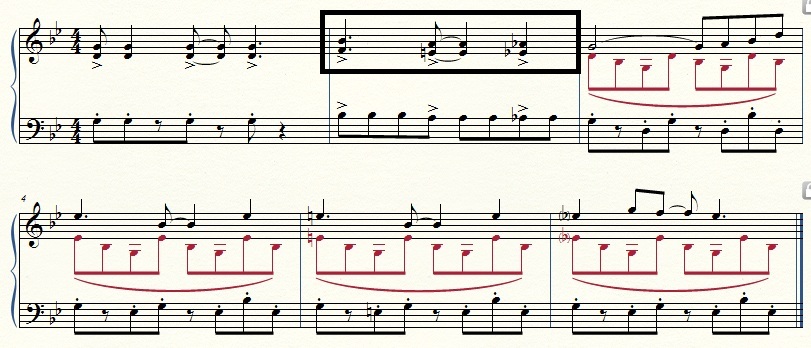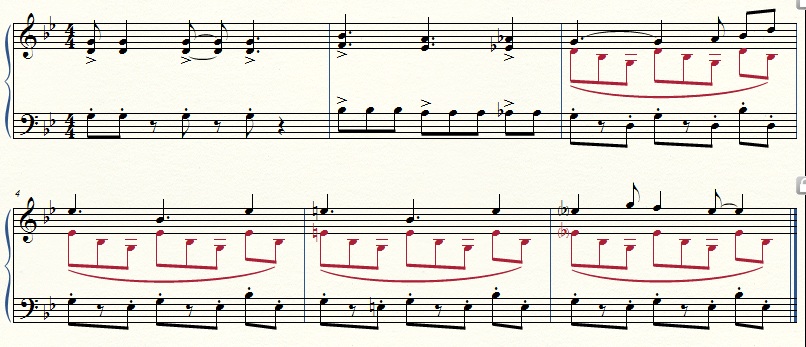|
“Music theory” can be somewhat of a polarizing force in music school ;-) Some people love it, some people despise it with every fiber in their being. The reason for this is that music theory involves staring at scores for long hours and analyzing each and every note for connections to each and every other note in the score. It can quickly become visually and mentally exhausting. And most students have trouble with the “ear-training” aspect of it; there's sight-singing, where you have to sing a melody line that you've never seen before, on the spot, in front of your entire class. Or dictation, listening to a piece you've never heard before and having to write down the melody and bass line by ear. It's very challenging, and the fact that most public schools only offer music theory courses in high school doesn't help. Learning to read and comprehend music is like learning a whole separate language—it's harder to learn as an adult, rather than as a child. Me, I was lucky in school! I enjoyed the sight-singing, dictation and ear-training courses because it's something I had been doing ever since I was a child. I started transcribing video game music as hobby when I was just 10 years old, because I wanted to be able to listen to the music without having to play the games. So when I started my first music theory courses in high school, I was surprised to discover that my ear-training was already very strong, at a more advanced level than most of my class. But even with that solid foundation, score analysis still would have my head aching and my eyes rolling after about half an hour. It's true that composers write with a form in mind--they create melodies and themes that work well together, have them connect in some way, use certain distinct elements to build the fabric of a piece, etc. So, it's always, always worth it to look at a score and discover the individual elements that make up the music; it's like looking at the blueprints of a machine and figuring out how all the parts work together; with that knowledge, you can start building your own machines! But the flipside is that you have to be careful that theorizing doesn't completely take over—all of a sudden, you find “things” in the music--motives, phrases, rhythms, intervals--that seem meaningful at first, but were quite possibly accidental, unintentional and had no bearing on how the piece was written. The fact that it's called music theory means you can basically draw any conclusions you want, but I think sometimes a composer chooses the notes not because of some mathematical equation, not because he had used a similar pattern upside down and backwards 400 measures earlier, not because the notes are actually code for the initials of his first girlfriend—he chooses them because he likes the way they sound. It's just plain aesthetic taste. There's also a great deal of intuition involved in composing—putting different elements together because it "feels right," without coming up with some musical formula to support it. Now that we've discussed the ups and downs of music theory :-P let's do a little theorizing! Today we're looking at Donkey Kong Country 2: Diddy's Kong Quest. The DKC soundtracks are some of my favorite of all time, especially DKC2. I have played this game more than any other game I've had in my possession, even more than Legend of Zelda: Ocarina of Time and Super Mario World. Words cannot convey how much I adore this game. In 2010, I was asked to promote our Indianapolis VGL show by performing some video game tunes at our ticket booth inside Gen Con. I tried to pick songs from all the big franchises that worked well as flute solos, but Donkey Kong proved pretty tricky. To me, the magic of the music came not just from the catchy melodies, but from the colors and orchestration. I use the term orchestration loosely; obviously, the music of the Donkey Kong games did not use a traditional symphony orchestra, but in this case, “orchestration” refers to the specific sounds and timbres that Wise used to produce the melody, harmony, bassline, textures, rhythms, etc. So there I was, listening to various DKC themes. I finally picked out “Snakey Chanty,” which had a fun, fast melody, and while I was transcribing it, I got some major deja vu. Something about the song seemed really familiar, like I had heard it somewhere else. I mean, I knew it was drawn from DKC's Gangplank Galleon with a jazzy twist, but there was something else about it that I just couldn't place. It was killing me—what was it about this song that sounded so familiar? Then it clicked. Take a listen to a bit of “Island Swing” (Jungle Hijinx) for a moment. Check out the rhythmic pattern in the drums, one of the most iconic game themes of all time: Now check out a bit of the melody-line of Snakey Chanty: Notice anything about the rhythm of each song? THEY'RE THE SAME.
I wanted to punch myself in the eyeball for not noticing the connection right away—the super catchy “Snakey Chanty” from DKC2 is based off of the rhythm of “DK Island Swing” from the previous game! With only slight differences, the rhythm has been transplanted into a totally new setting; originally an earthy jungle beat, it's now a breezy, almost Dixieland Jazz type melody. Wise rehashed an old theme into something brand new, but still totally recognizable. SO! Why did I write all of that stuff about music theory in the beginning of this article? Because I want to make it perfectly clear that is just my theory. Yes, Snakey Chanty and DK Island Swing share the same rhythm, that is a fact. But whether this connection was intentional or completely intuitive on the part of the composer...that's something we'd have to ask David Wise himself ;-) But whether it was intentional or not, I think it was a really ingenious way to musically connect two games in a series, without simply copying the same exact track from one game to the other. NO WONDER HIS NAME IS DAVID WISE. HA-HA SEE WHAT I DID THERE. Enjoy this week's transcriptions of Bayou Boogie, Snakey Chanty and Swanky's Swing from Donkey Kong Country 2: Diddy's Kong Quest! More on the way!
6 Comments
Playing Skyward Sword has me in a Zelda mood, so let's take a look at a very popular tune from Zelda II: Adventure of Link! I haven't played the game myself and I'm told that it was not the best game in the Zelda franchise, but the Palace Theme is a favorite tune of many gamers I've met. A lot of video game music in the 80's and early 90's depended on strong melodies to make up for the limited hardware of its time. So, it makes sense that some of the most memorable game themes of all time are from that era. The melodies had to be super catchy, but what is it about melodies that makes them super catchy? What's the “hook” in the Palace Theme that keeps us listening? Let's get a little technical for a second: the definition of “melody” is a succession of musical tones which is perceived as a single entity. A melody, in its most basic form, is made up of two things: pitch and rhythm. So let's look at the first part of the Palace Theme's melody, just the pitches for a moment. Not the craziest melody in the world, right? I'm not saying that it isn't a “good” melody, I personally definitely enjoy it (and it's all up to your personal taste anyway)--but I notice that the melody-line isn't what I'd necessarily call very "active." For a point of reference, let's compare it to a melody like the original Legend of Zelda Overworld. Compared to the Palace Theme, it seems to me like there's a LOT more going on in the Overworld theme, right? The melody has a larger contour (shape), the harmonies and chords supporting it are varied and colorful, the rhythmic pattern with alternating triplets and dotted eighth-sixteenths grabs your attention. Ah-hah, the rhythm! That's just as important to the melody as the pitches—so let's look at the Palace Theme's rhythm for a moment. Right away, in the second bar, we see the rhythmic pattern that will drive the entire piece: dotted quarter, dotted quarter (represented by an eighth tied to a quarter), then quarter. The middle voice has an even stronger role in reflecting this rhythmic pattern—the arpeggios reflect the 3-3-2 pattern as well. If I were to change the beaming of this entire passage to reflect the rhythmic pattern, it would look like this. This is called additive rhythm: when a rhythmic pattern features irregular groups of durations. In common 4/4 time, normally we would just divide each beat into smaller groups; the whole note is divided into 2 halves, the 2 halves are divided into 4 quarters, the 4 quarter notes into 4 groups of eighth notes, etc. This is called divisive rhythm. But in this piece, the rhythm strongly reflects beat durations of 3 eighths, 3 eighths and then 2 eighths—we're adding the smaller beats up to make the bigger groups.
You see additive rhythm most often in asymmetrical meters like 5/8, 7/8—any meter that doesn't divide the beats equally. But as we see in the Palace Theme, additive rhythm can be applied to any type of meter, including the symmetrics. Contemporary composers sometimes notate additive rhythms in the time signatures themselves; in this case, it would be 3+3+2/8. So why didn't I notate it as such in my sheet music? Because there are sections of the piece that do not use additive rhythm. The B section starting at m. 27 is a fluid triplet feel on top of the sweeping 16th arpeggios, which is a really awesome part of the piece as well—by setting up such a strong additive pattern for A section, the B section's more straightforward, divisive rhythmic pattern becomes more noticeable and is a welcome break. Not only that, but the contour of the melody suddenly blows up, it starts a climbing scalar pattern; the rhythm has clearly become secondary to the pitches of the melody. Pretty cool right? In the first half of the piece, the rhythm is the driving force; in the second half, the pitches are the driving force. In this short piece, the composer has highlighted and featured each part of what makes up a strong melody: pitch and rhythm. Bam! Two points for Nakatsuka-san! Enjoy this week's transcriptions of the Main Titles, Overworld and Palace themes from Zelda II: The Adventure of Link. More on the way! |
AuthorVideo game music was what got me composing as a kid, and I learned the basics of composition from transcribing my favorite VGM pieces. These are my thoughts and discoveries about various game compositions as I transcribe and study them. Feel free to comment with your own thoughts/ideas as well! Archives
July 2017
Categories
All
|








 RSS Feed
RSS Feed
